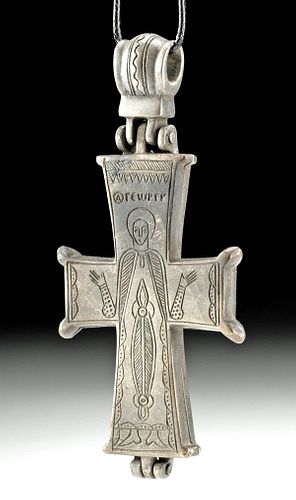Byzantine Silver Alloy Reliquary Cross W/ St. George
Lot 64b
About Seller
Artemis Fine Arts
686 S Taylor Ave, Ste 106
Louisville, CO 80027
United States
Selling antiquities, ancient and ethnographic art online since 1993, Artemis Gallery specializes in Classical Antiquities (Egyptian, Greek, Roman, Near Eastern), Asian, Pre-Columbian, African / Tribal / Oceanographic art. Our extensive inventory includes pottery, stone, metal, wood, glass and textil...Read more
Categories
Estimate:
$4,000 - $6,000
Absentee vs Live bid
Two ways to bid:
- Leave a max absentee bid and the platform will bid on your behalf up to your maximum bid during the live auction.
- Bid live during the auction and your bids will be submitted real-time to the auctioneer.
Bid Increments
| Price | Bid Increment |
|---|---|
| $0 | $25 |
| $300 | $50 |
| $1,000 | $100 |
| $2,000 | $250 |
| $5,000 | $500 |
| $10,000 | $1,000 |
| $20,000 | $2,500 |
| $50,000 | $5,000 |
| $100,000 | $10,000 |
| $200,000 | $20,000 |
About Auction
By Artemis Fine Arts
Oct 8, 2020
Set Reminder
2020-10-08 10:00:00
2020-10-08 10:00:00
America/New_York
Bidsquare
Bidsquare : Exceptional Antiquities, Asian, Ethnographic
https://www.bidsquare.com/auctions/artemis-gallery/exceptional-antiquities-asian-ethnographic-5796
Museum-worthy examples of Egyptian, Greek, Roman, Etruscan, Near Eastern, Far East / Asian, Pre-Columbian, African / Tribal,Oceanic, Native American, Spanish Colonial, Russian, Fossils, Ancient Jewelry, Fine Art, so much more! Artemis Fine Arts info@artemisfinearts.com
Museum-worthy examples of Egyptian, Greek, Roman, Etruscan, Near Eastern, Far East / Asian, Pre-Columbian, African / Tribal,Oceanic, Native American, Spanish Colonial, Russian, Fossils, Ancient Jewelry, Fine Art, so much more! Artemis Fine Arts info@artemisfinearts.com
- Lot Description
Ancient Near East, Holy Land, early Byzantine Empire, ca. 7th to 8th century CE. A beautiful cast-silver alloy reliquary cross comprised of two crucifixes which fit together incised with an open-armed haloed figure with hands in supine position indicative of blessing, identified by the Greek writing above his head as St. George, on one side and a petaloid cross motif with a central tondo of a haloed figure, likely the Virgin Mary, in a stola with hands opened upward flanked by the Greek monogram for "Mother of God" on the opposite side. St. George wears healed boots and a long cassock adorned with a hanging clerical collar, striped shoulders, a central geometrical phytomorphic design, and polka dotted sleeves. Embellished with a decorative perimeter, this lovely pendant is topped with a large tubular suspension loop, also ornamentally incised, where it previously opened to hold a relic. This remarkably well preserved reliquary is a rare treasure from the Byzantine world to ours! Size: 1.75" L x 0.75" W x 4" H (4.4 cm x 1.9 cm x 10.2 cm); Chain Size: 22.25" L (56.5 cm); 90.7 grams.
Before the Greek inscription of George appears a symbol that looks like an A inside an O representing the Greek letters of Alpha and Omega, the first and last letters of the Greek alphabet and an early Christian title for Christ and God. St. George was one of the main Christian martyrs of the Eastern Orthodox Church and is the most common figure found on this type of cross. According to Greek legend, the saint was born in Cappadocia to Greek parents who raised him in the Christian faith. Once his parents passed, he joined the Roman army and, whence demanded to recant his faith for the Roman empire, he was sentenced to death by beheading by Roman Emperor Diocletian. Relics - physical remains of saints or objects associated with Christ, such as pieces of the True Cross, the shroud His body was wrapped in, or the Holy Grail - held tremendous power in early Christianity. Reliquaries, objects designed to hold relics, were usually kept in cathedrals or churches, but some wealthy individuals were able to possess them. The less wealthy could purchase replicas of reliquaries, small reliquaries containing less precious items like soil from a holy site, or metal items produced as a form of souvenir from shrines. Later, many of these objects were destroyed in times of religious conflict or strife; ones that are intact, like this one, have often been passed down through generations of families.
A similar reliquary cross can be found in Gallery 303 in the Metropolitan Museum of Art (Accession #: 2000.526.2).
Provenance: ex Estate of Eldert Bontekoe, Pegasi Numismatics, Ann Arbor, Michigan USA acquired before 2000
All items legal to buy/sell under U.S. Statute covering cultural patrimony Code 2600, CHAPTER 14, and are guaranteed to be as described or your money back.
A Certificate of Authenticity will accompany all winning bids.
We ship worldwide and handle all shipping in-house for your convenience.
#157931Modern stringing. Minor nicks/chips and scratches to edges and surface. Encrustations and earthen deposits commensurate with age. Lustrous and intact.Condition
- Shipping Info
-
All shipping is handled in-house for your convenience. Your invoice from Artemis Gallery will include shipping calculation instructions. If in doubt, please inquire BEFORE bidding for estimated shipping costs for individual items.
-
- Buyer's Premium



 EUR
EUR CAD
CAD AUD
AUD GBP
GBP MXN
MXN HKD
HKD CNY
CNY MYR
MYR SEK
SEK SGD
SGD CHF
CHF THB
THB













